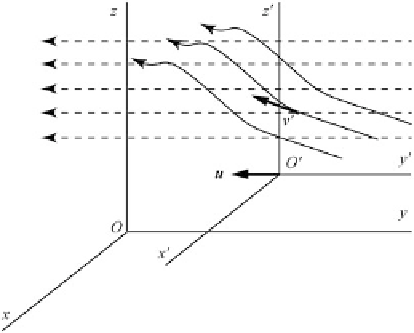Geology Reference
In-Depth Information
E
0
D
E
C
u
B
(4.7)
Combining (
4.3
)and(
4.4
) with (
4.7
) we ob-
tain the following expression for the density of
current in the laboratory frame:
j
D
j
0
C
¡
u
D
¢E
0
C
¡
u
D
¢.E
C
u
B/
C
¡
u
(4.8)
This is the general form of Ohm's law in the
laboratory frame. It establishes the dependency
of the current density through a conductor that
is moving with velocity
u
from the electric and
magnetic fields and from the local scalar charge
density. The convective term ¡
u
in (
4.8
)isoften
negligible in comparison with the transport by
conduction, which is proportional to ¢.Forexam-
ple, in the case of the Earth's core the conductiv-
ity is thought to be very large: ¢
4
10
5
Sm
1
.
In this instance, Ohm's law assumes the follow-
ing simpler form:
Fig. 4.1
Flow of electric charges through a moving con-
ductive fluid. The fluid moves leftward with uniform
velocity
u
(
dashed lines
). The charges have local density
¡ and velocity
v
0
in the reference frame
x
0
y
0
z
0
of the
fluid, so that the flow of charges through the conductor
is represented by a density of current
j
0
D
¡
v
0
point of view of an observator in the laboratory
frame, the velocity of the charges is
v
D
v
0
C
u
,
so that the density of current will be given by:
j
D
¡
v
D
¡
v
0
C
u
D
j
0
C
j
c
j
D
¢.E
C
u
B/
(4.9)
(4.5)
Now we want to determine the relation be-
tween the electric field
E
0
in (
4.4
) and the electric
field
E
observed in the laboratory frame. In this
frame, a test charge that is at rest in the moving
frame appears to be subject to the simultaneous
action of an electrostatic field
E
and a Lorentz
Therefore, the total force exerted on a charge
q
is
given by:
r
B
D
0
¢.E
C
u
B/
(4.10)
This form of the Maxwell-Ampere equation
combines a macroscopic current, depending on
E
, with a term depending from the velocity
u
of
the conductor. In the case of the Earth's mag-
netism, the electric field
E
at the right-hand side
of (
4.10
) cannot be a conservative field, generated
by a distribution of charges as in Eq. (
4.1
). In
fact, the Earth's mantle is essentially an elec-
tric insulator, with a conductivity ranging be-
tween 10
4
and 1 S m
1
(Dobson and Brodholt
2000
), thereby, the source of the electric field
in (
4.10
) must be somewhere within the Earth's
core. A possibility could be a distribution of
electric charges in the solid inner core, a sort
of giant battery, but this solution would require
rather special conditions that cannot be reason-
ably hypothesized (for an in-depth discussion, see
Elsasser
1939
). Therefore, the problem is: what
is the origin of the currents flowing through the
F
D
q.E
C
u
B/
(4.6)
This is in fact the complete form of the Lorentz
force. Now let us consider an observer in the
moving frame. From the point of view of this
person, the test particle
q
is at rest, so that the
unique force that comes to play is the electrostatic
force
q
E
0
. Therefore, in the moving frame it
results that
F
0
D
q
E
0
. The two forces
F
and
F
0
must be clearly equal, because the acceleration
is the same in the two reference frames (
u
is a
constant vector). Consequently, we have:

